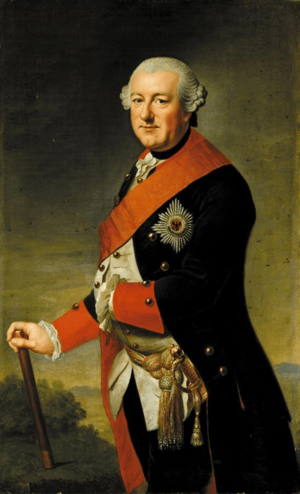Charles I, Duke of Brunswick-Wolfenbüttel facts for kids
Quick facts for kids Charles I |
|
|---|---|

Portrait by Johann Georg Ziesenis
|
|
| Prince of Brunswick-Wolfenbüttel | |
| Reign | 2 September 1735 – 26 March 1780 |
| Predecessor | Ferdinand Albert II |
| Successor | Charles William Ferdinand |
| Born | 1 August 1713 Brunswick |
| Died | 26 March 1780 (aged 66) Brunswick |
| Spouse | Princess Philippine Charlotte of Prussia |
| Issue | Charles William Ferdinand, Duke of Brunswick Prince Georg Franz Sophie, Margravine of Brandenburg-Bayreuth Prince Christian Ludwig Anna, Duchess of Saxe-Weimar-Eisenach Prince Frederick Augustus Prince Albrecht Heinrich Princess Louise Prince Wilhelm Adolf Elisabeth Christine, Crown Princess of Prussia Princess Friederike Augusta Dorothea, Abbess of Gandersheim Prince Maximilian Julius Leopold |
| House | House of Guelph |
| Father | Ferdinand Albert II, Duke of Brunswick-Wolfenbüttel |
| Mother | Duchess Antoinette of Brunswick-Wolfenbüttel |
Charles (born August 1, 1713, in Brunswick – died March 26, 1780, in Brunswick) was a German ruler. He was known as the Duke of Brunswick-Lüneburg. From 1735 until he passed away, he was the Prince of Brunswick-Wolfenbüttel.
Contents
Life of Charles I
Charles was the oldest son of Ferdinand Albert II, who was also a Duke. Before he became a ruler, Charles fought in battles against the Ottoman Empire. He inherited the Principality of Brunswick-Wolfenbüttel from his father in 1735. His mother was a cousin of Empress Maria Theresa.
Supporting Education and Arts
Charles was very interested in education and culture. In 1745, he started a new school called the Collegium Carolinum. This school is now known as the Technical University of Brunswick. He also hired a famous writer, Gotthold Ephraim Lessing, to work as a librarian. Lessing managed the ducal library, which was called the Bibliotheca Augusta. A scientist named Lorenz Heister even named a plant genus, Brunsvigia, after Charles. This was to thank him for supporting the study of plants.
Economic Efforts and Challenges
Charles tried hard to make his state's economy stronger. For example, he started the Fürstenberg Porcelain Company, which made beautiful porcelain. He also made fire insurance mandatory for everyone. This meant people had to have insurance to protect their homes from fire. However, he found it difficult to manage the state's money. Because of these financial problems, his oldest son, Charles William Ferdinand, took over the government in 1773.
Role in the American Revolution
When the American Revolution began in 1775, Charles saw a chance to earn money for his state. He decided to rent out his army to Great Britain. In 1776, Charles signed a deal with his cousin, King George III. This agreement meant that 4,000 Brunswick soldiers would go to America to fight with the British army.
These soldiers were led by General Friedrich Adolf Riedesel. They fought in General John Burgoyne's army at the Battles of Saratoga in 1777. After these battles, the Brunswick troops were captured. They became part of what was called the Convention Army. Even though the surrender terms said the soldiers could go back to Europe, the American Continental Congress did not allow it. The Convention Army stayed as prisoners in America until the war ended in 1783.
Family Life
In 1733, Charles married Philippine Charlotte. She was the daughter of King Frederick William I of Prussia and the sister of Frederick the Great. They had many children who grew up to be adults:
- Charles William Ferdinand (1735–1806), who later became the father of Queen Caroline of Brunswick. Caroline married George IV of Great Britain.
- Sophie Caroline Mary (1737–1817), who married Frederick, Margrave of Brandenburg-Bayreuth.
- Anna Amalia (1739–1807), who married Ernest Augustus II, Duke of Saxe-Weimar-Eisenach.
- Frederick Augustus (1740–1805).
- Albert Henry (1742–1761), who passed away without children.
- William Adolf (1745–1770), who also passed away without children.
- Elizabeth Christine Ulrike (1746–1840), who married King Frederick William II of Prussia. She was the mother of Frederica, Duchess of York.
- Augusta Dorothea, Abbess of Gandersheim (1749–1803).
- Maximilian Jules Leopold (1752–1785), who passed away without children.



